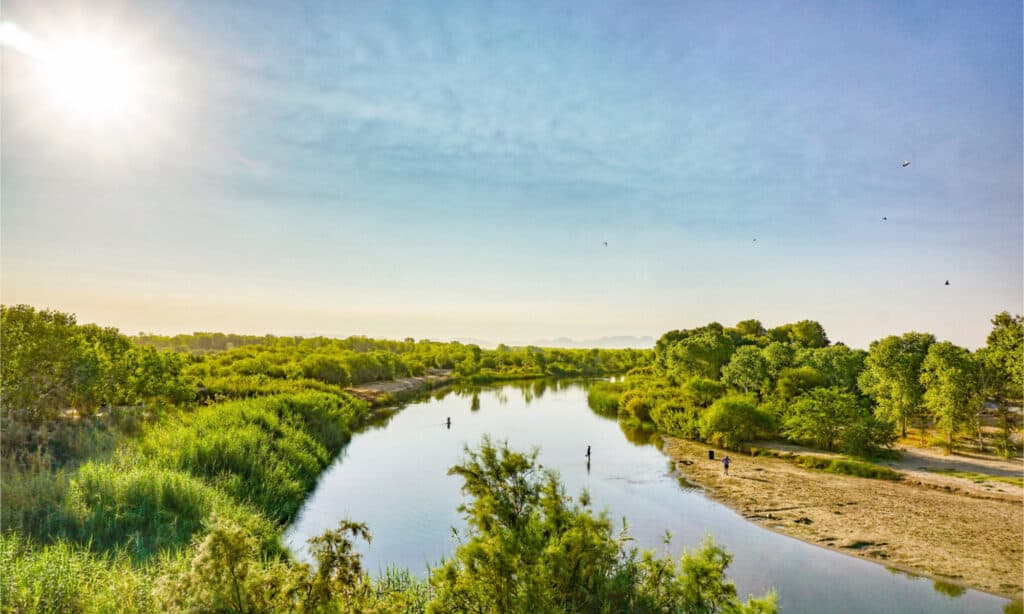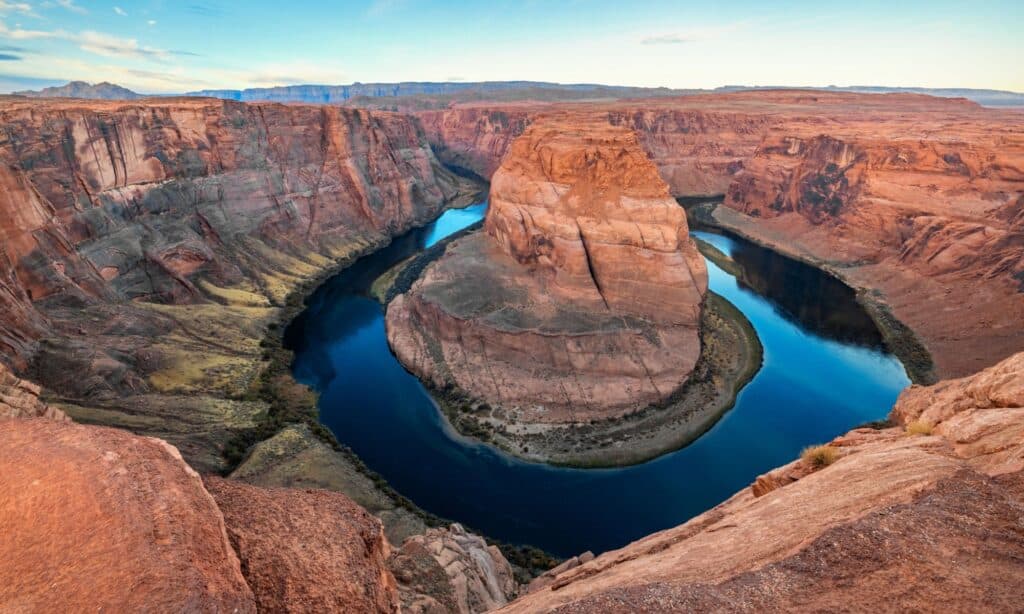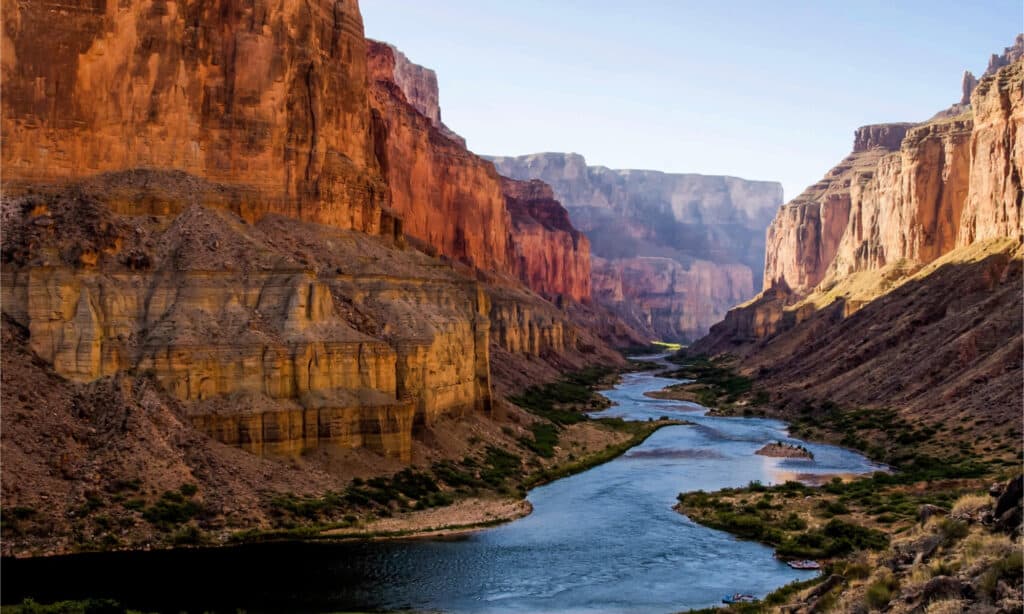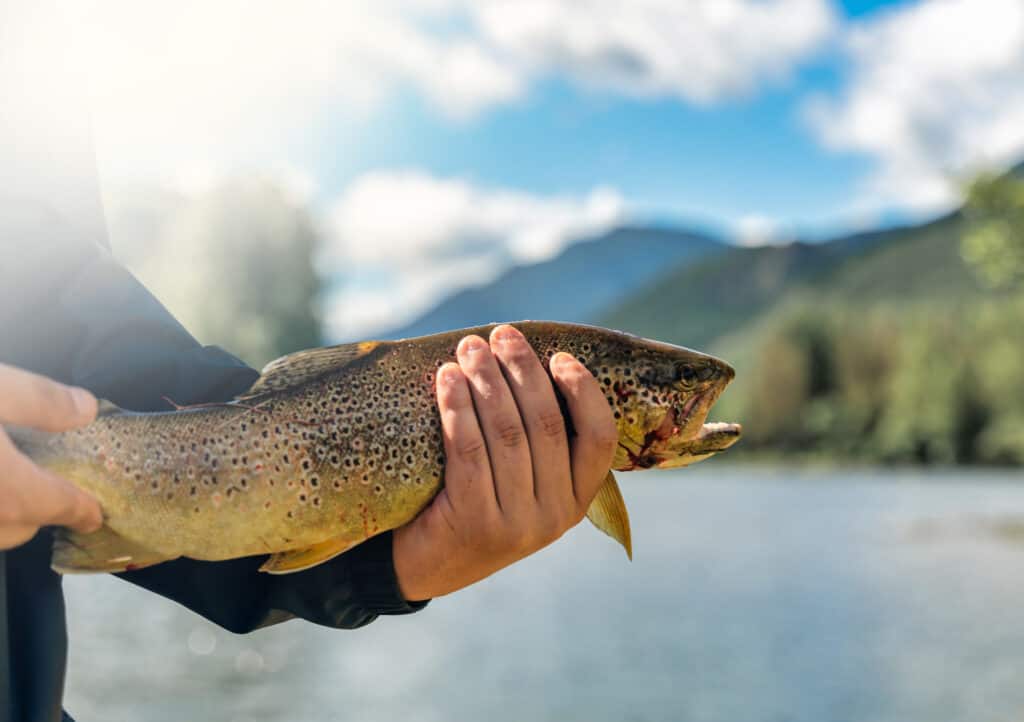The “Lifeline of the Southwest,” as it is known, the Colorado River is the sixth-longest river in the U.S. It rises in the Colorado and Wyoming snowcapped mountains and provides hydroelectric power and water for about 40 million people in the United States and Mexico. Due to its purpose for so many uses, it is also considered one of the world’s most heavily regulated rivers.
Tourists sailing along the Colorado River constantly ask the Grand Canyon river guides a recurring question; “How deep is the Colorado River?” It sounds like a simple question, but the answer has always remained unknown as researchers and scientists still debate over the river’s actual depth.
For today’s article, we’re going to delve deeper into one of the most important rivers in the country and will try to discuss how deep it is as well as its history, wildlife, and other unique features.
What is the actual depth of the Colorado River?

It is said that the average depth of the Colorado River is about 20 feet, yet there are holes underneath its surface that go as deep as 90 feet.
©Enrique Alcala/Shutterstock.com
Researchers and scientists are still trying to come up with more definitive conclusions about the Colorado River’s depth. Even the Grand Canyon river guides couldn’t come up with an answer when tourists asked them the question. When people look up the internet, the responses vary based on the year and how truthful the information is. New studies suggest more accurate solutions based on the actual depth of the river.
- It is said that the average depth of the Colorado River is about 20 feet, yet there are holes underneath its surface that go as deep as 90 feet.
- Other places in the river are just 6 feet deep, where there are rapids and calm water combined.
- With the use of various modern technologies such as aerial photography and multibeam sonar sensors dropped into the water, they can record elevation points in the riverbed.
- A network of about 1,500 survey benchmarks along the Colorado River collected data about the river over time, allowing researchers to detect river depth changes.
- A geologist at Northern Arizona University and the leader of the survey project, Matt Kaplinski, presented his collected data that shows the river is 25 feet in depth, with the deepest going to 87 feet.
- From Phantom Ranch to National Canyon, the researchers will keep mapping 240 miles of the Colorado River to collect more data and eventually provide a more precise and accurate representation of the river’s depth.
How long is the Colorado River?

The Colorado River spans 2,334 kilometers (1,440 miles) from its start to the Gulf of California.
©Lebid Volodymyr/Shutterstock.com
The Colorado River spans 2,334 kilometers (1,440 miles) from its start to the Gulf of California. It flows through seven western states: Arizona, California, Colorado, Nevada, New Mexico, Utah, and Wyoming. All seven states that this river flows through depend on its water supply, fish, hydropower production, and other benefits. The river also flows through eleven national parks, including the Grand Canyon National Park, Rocky Mountain National Park, Arches National Park, and more. Its 25 important tributaries, including Green, Little Colorado, Gila, White, Yampa, and San Juan, provide water for millions in the seven states it flows through.
Does the Colorado River have any unique features?
The Colorado River is best known for flowing through beautiful canyons and having whitewater rapids perfect for various activities. There is a famous spot within the river called the Horseshoe Bend, a massive piece of rock placed in the middle of the river in the shape of a horseshoe. Because of its recreational water opportunities, the Colorado River is called the “Granddaddy of rafting trips.”
What does the wildlife look like in the Colorado River?

The Colorado River is home to a diverse number of animal species.
©Beth Ruggiero-York/Shutterstock.com
In the environment and waters of the Colorado River, it is no surprise that it’s also home to a diverse number of species. In the Grand Canyon alone, many species of animals are already thriving in its areas. 447 species of birds, 91 mammals, 48 reptiles, 10 species of amphibians, and hundreds of invertebrates like spiders make the Grand Canyon their home.
The wildlife in the Colorado River consists of:
Mammals
The beaver is the most seen and largest mammal in the Colorado River. Since the river has a forceful flow, beavers build dams along the river banks. On the other hand, muskrats may also be found building dens along the river’s shorelines. River otters were mammals that once made the river their home, but after a few disappearances already, they have moved to another habitat. Several numbers of mule deer, bighorn sheep, coyotes, bobcats, and gray foxes can also be found along the river corridors.

River otters were mammals that once made the river their home, but after a few disappearances already, they have moved to another habitat.
©iStock.com/edevansuk
Fish
Even if many fish species are wiped out by its cooling water, the Colorado River still boasts several fish thriving in its chilly waters. Some of the fish include smallmouth and largemouth bass, catfish, bluegill, rainbow trout, and crappie, which are usually the ones that are caught in sports fishing. Native species of fish that can adapt to its cool waters are minnows, speckled dace, and bluehead suckers.

Trout are prevalent in the Colorado River.
©iStock.com/Armando Oliveira
Birds
The Colorado River often serves as a travel corridor or habitat for many migratory birds and waterfowl, like the great blue heron, the American avocet, the American wigeon, the red-winged blackbird, the western bluebird, the burrowing owl, the Mexican spotted owl, and the southwestern willow flycatcher.
Reptiles & Amphibians
The National Park Service reports approximately 47 reptile species in the Grand Canyon, with reported sightings of reptiles within the Colorado River itself. Reptiles and amphibians that thrive in the river waters include the western painted turtle, rattlesnake, sidewinder, gopher snake, short-horned lizard, red-spotted toad, the common kingsnake, and other snakes.
What are some interesting facts about the Colorado River?
History of the Colorado River
- Although there is no way to pinpoint the actual date, it is possible that the Colorado River is approximately six million years old.
- The first sign of human inhabitants of the Colorado river basin was around 12,000 years ago. The Paleo-Indians, who lived the hunter-gatherer lifestyle, came from North Asia during the last glacial phase of the Pleistocene period.
- Native people inhabited the Colorado River basin around 8000 years ago. They led nomadic, or what is known as the Desert Archaic, lifestyle and lived on the natural resources and games.
- From 2000 to 700 years ago, agriculture-based communities lived up and down the Colorado river, known as the Freemont Culture, many native tribes followed this lifestyle. However, during a drought in the 14th century, many of these settlements were wiped out.
Mapping of Colorado River
- The Spanish explorers started mapping the Colorado River basin at the beginning of the sixteenth century.
- In 1539 Francisco de Ulloa, an explorer under the commission of Hernán Cortés, was the first to explore the coast of Baja where the Colorado meets the Gulf. He also explored the Colorado River and debunked the misconception that California was an island.
- He also named the Gulf as ‘Mar Bermejo’, alluding to the color of the water due to the red plankton native to the sea.
- Thus began the colonization of California around the Colorado River watershed, which became a part of Mexico upon its independence in the year 1821.
- Later in 1846 most of the area was reclaimed and became a part of US territories again, however, the river still remained largely unexplored until 1869.
- In 1869 John Wesley Powell, a major in the US Army, along with 9 other adventurers, set out to explore the Colorado River.
Other Amazing Events in the History of Colorado River
- In 1859, the Gold Rush reached Colorado, also known as the ‘Pikes Peak Gold Rush’. In the next few years, people started pouring into the Colorado River basin.
- The Colorado River is still sought out for the gold found in the water.
- The invasion by the Spanish and later the Gold Rush, propelled the Natives tribes from the area, as the lands under the control of Indians could not be prospected.
- Missionaries also played a huge part in displacing and converting Indian tribes and westernizing them. Thus causing a loss of culture and their native ways.
Human Control of the Colorado River
The Colorado river is one of the most utilized globally because of the amount of water flowing through it, which allows it to be used for many purposes. It currently has over 40 dams, channels, and aqueducts that serve a human purpose by diverting the river, irrigation, generating power, populating areas, and creating attractions, etc.
Here is a list of Dams on the Colorado River and the purpose they serve:
| No | Dam Name | Purpose | Year Completed |
|---|---|---|---|
| 1 | Morelos Dam | Irrigation | 1950 |
| 2 | Laguna Diversion Dam | Diversion | 1905 |
| 3 | Imperial Dam | Irrigation | 1938 |
| 4 | Palo Verde Dam | Diversion | 1958 |
| 5 | Headgate Rock Dam | Irrigation | 1941 |
| 6 | Parker Dam | Power Generation, Irrigation, Municipal Requirement | 1938 |
| 7 | Davis Dam | Power Generation and Regulation | 1951 |
| 8 | Hoover Dam | Power Generation, Irrigation, and Flood Control Municipal Requirement | 1936 |
| 9 | Glen Canyon Dam | Power Generation and Regulation | 1966 |
| 10 | Price-Stubb Dam | Irrigation | 1911 |
| 11 | Grand Valley Diversion Dam | Irrigation | 1916 |
| 12 | Windy Gap Dam | Irrigation Municipal Requirement | 1970 |
| 13 | Granby Dam | Irrigation Municipal Requirement | 1950 |
| 14 | Shadow Mountain Dam | Irrigation Municipal Requirement | 1946 |
| 15 | Blue Mesa Dam | Hydropower and Flood Control | 1966 |
| 16 | Dillon Dam | Irrigation Municipal Requirement | 1963 |
| 17 | Flaming Gorge Dam | Hydropower and Flood Control | 1964 |
| 18 | Fontenelle Dam | Irrigation Flood Control | 1964 |
| 19 | Green Mountain Dam | Hydropower | 1943 |
| 20 | Joes Valley Dam | Irrigation Municipal Requirement | 1966 |
| 21 | McPhee Dam | Irrigation Flood Control | 1984 |
| 22 | Morrow Point Dam | Hydropower Generation | 1968 |
| 23 | Navajo Dam | Irrigation, Flood Control Municipal Requirement | 1962 |
| 24 | Ridges Basin Dam | Irrigation | 2007 |
| 25 | Ridgway Dam | Irrigation Flood Control | 1987 |
| 26 | Ruedi Dam | Irrigation, Municipal Requirement | 1968 |
| 27 | Scofield Dam | Irrigation, Municipal Requirement | 1946 |
| 28 | Soldier Creek Dam | Irrigation, Municipal Requirement | 1974 |
| 29 | Starvation Dam | Irrigation | 1970 |
| 30 | Taylor Park Dam | Irrigation | 1937 |
| 31 | Vallecito Dam | Irrigation | 1941 |
| 32 | Vega Dam | Irrigation | 1959 |
| 33 | Williams Fork Dam | Irrigation, Municipal Requirement | 1959 |
| 34 | Wolford Mountain Dam | Irrigation, Municipal Requirement | 1996 |
| 35 | Bartlett Dam | Irrigation Flood Control | 1939 |
| 36 | Coolidge Dam | Irrigation Flood Control | 1930 |
| 37 | Horse Mesa Dam | Hydropower | 1927 |
| 38 | Horseshoe Dam | Flood Control | 1946 |
| 39 | Mormon Flat Dam | Hydropower | 1925 |
| 40 | New Waddell Dam | Irrigation, Municipal Requirement | 1994 |
| 41 | Painted Rock Dam | Flood Control | 1960 |
| 42 | Sand Hollow Dam | Irrigation, Municipal Requirement | 2002 |
| 43 | Stewart Mountain Dam | Hydropower | 1930 |
| 44 | Theodore Roosevelt Dam | Power Generation, Irrigation Flood Control Municipal Requirement | 1911 |
One of its most prominent sights was the Hoover Dam, built between 1931 and 1936 to control the river. The Hoover Dam provides water for Lake Mead, an artificial reservoir built to provide more water supply for Arizona, Nevada, California, and northern Mexico. It is deemed one of the world’s largest water reservoirs and is essential in maintaining industrial water and irrigation water for downstream residents to use.
Current Condition of Colorado River
The Colorado River has been under the threat of ongoing draught caused by overallocation and climate change since 2000 when it was first observed that Lake Mead has started to dry. It is a fact that the river has lost 20% of its water in the last century. As a result, the number of trees in the basin is reducing at an alarming pace, so are the insects, birds, amphibians, and fish populations. Recent studies have shown that the Mojave Desert has lost 43% of its native population of animals. It is also predicted that by 2050, the temperature of the Colorado River will increase by 5 degrees.
Learn about the depth of the Columbia River.
Thank you for reading! Have some feedback for us? Contact the AZ Animals editorial team.








